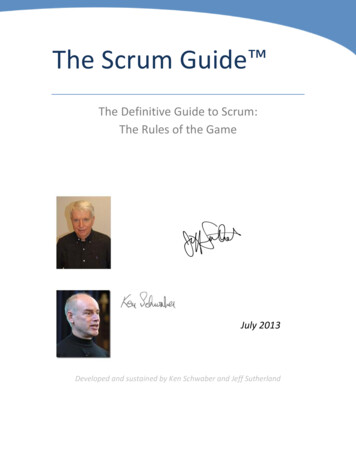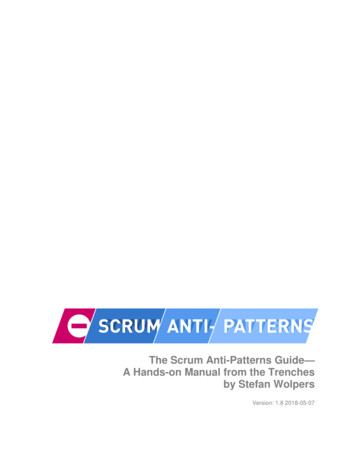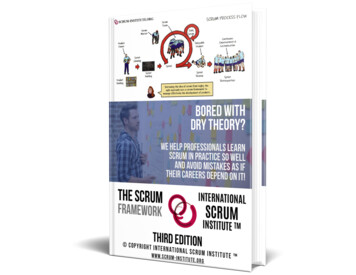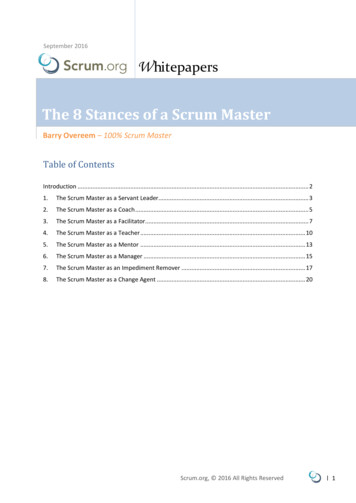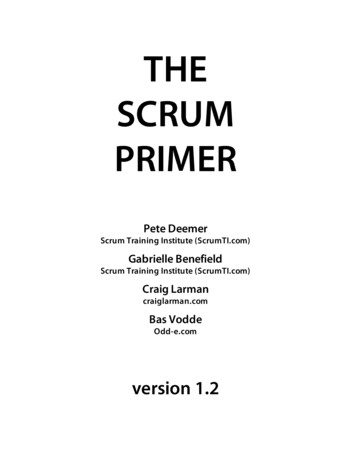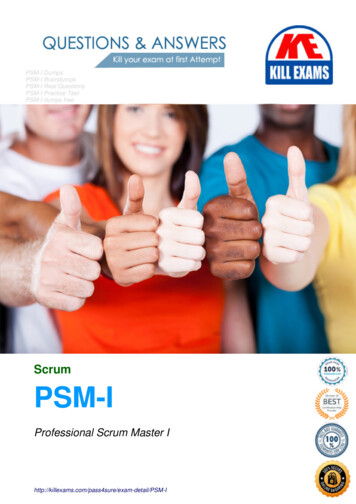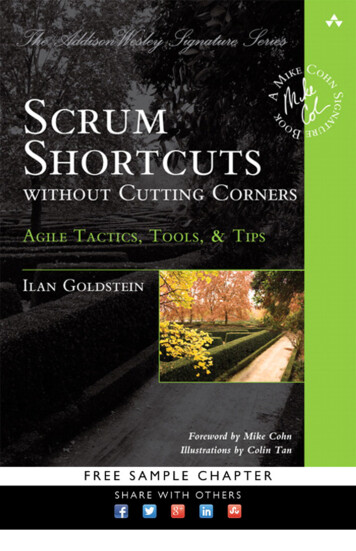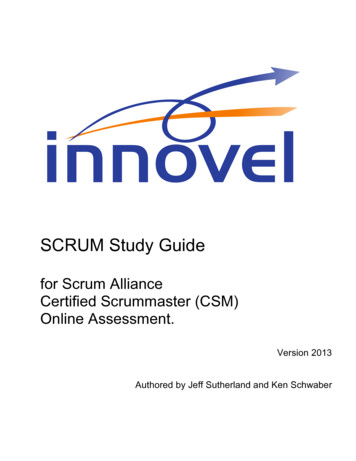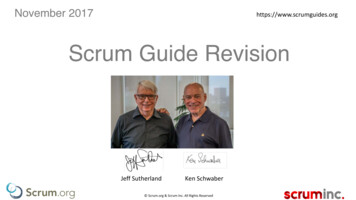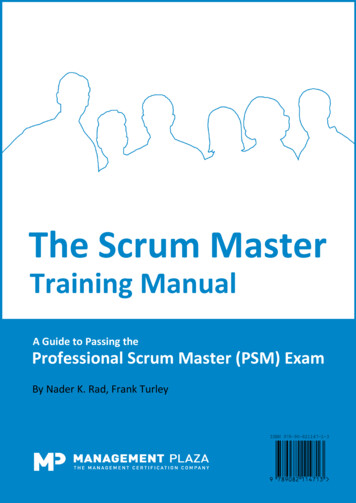
Transcription
The Scrum Master Training ManualA Guide to Passing the Professional Scrum Master (PSM) ExamThe Scrum MasterTraining ManualA Guide to Passing theProfessional Scrum Master (PSM) ExamBy Nader K. Rad, Frank TurleyPage 0, About the Authors
The Scrum Master Training ManualA Guide to Passing the Professional Scrum Master (PSM) ExamThe Scrum Master Training ManualA Guide to Passing the Professional Scrum Master (PSM) ExamBy Nader K. Rad, Frank TurleyManagement PlazaVr. 1.0 (check for newer versions at http://mgmtplaza.com/latestversion)Copyright 2013 Management PlazaAll rights reserved. With the exception of brief passages andquotes for reviewing or commenting purposes, no part of thispublication may be reproduced or transmitted in any form orby any means without prior consent of Management Plaza.Page 1, About the Authors
The Scrum Master Training ManualA Guide to Passing the Professional Scrum Master (PSM) ExamTable of ContentsAbout the Authors . 3About Management Plaza . 4About the Management Plaza Classroom Scrum Course . 6Scrum.Org Certification . 71. Introduction . 91.1. What Is Scrum and Agile? . 91.2. Agile Manifesto . 91.3. When to Use Scrum vs. When to Use Traditional Methods . 101.4. Facts and Fictions about Scrum . 112. Typical Scrum Timeline . 133. Scrum Roles . 173.1. Scrum Team . 173.2. Role 1: The Product Owner . 193.3. Role 2: The Scrum Master . 213.4. Role 3: The Development Team. 223.5. Other Roles . 233.6. So Who Is the Project Manager? . 234. Scrum Events . 254.1. The Nature of Scrum Events . 254.2. The Time-Box Concept . 254.3. Event 1: The Sprint . 264.4. Event 2: Sprint Planning . 274.5. Event 3: Daily Scrum . 314.6. Event 4: Sprint Review . 324.7. Event 5: Sprint Retrospective . 334.8. Product Backlog Grooming . 344.9. Slack . 345. Scrum Artifacts . 375.1. Artifact 1: Product Backlog . 375.2. Artifact 2: Sprint Backlog . 435.3. Artifact 3: Increment . 505.4. Artifact 4: Definition of “Done” . 505.5. Artifact 5: Monitoring Progress toward a Goal. 515.6. Artifact 6: Monitoring Sprint Progress . 526. Summary . 556.1. Scrum Roles . 556.2. Scrum Events . 566.3. Scrum Artifacts . 577. Self-Assessment . 617.1. Questions . 617.2. Answers . 708. Sample PSM Exams . 758.1. Sample Exam #1 . 758.2. Sample Exam #2 . 798.3. Answers for Exam #1 . 838.4. Answers for Exam #2 . 85Page 2, About the Authors
The Scrum Master Training ManualA Guide to Passing the Professional Scrum Master (PSM) ExamAbout the AuthorsNader K. Rad is a project management consultant, author, and trainerat Management Plaza. His career started in 1997 and he has beeninvolved in many projects in different industries. He has designed anumber of project management courses, prepared a number of elearning materials, and written more than 40 books and plenty ofpractical articles on project management concepts and standards,planning software, scheduling, etc.He is certified as PMP , PRINCE2 Practitioner, AgilePM Foundation,CSM , and PSM I.Author’s website: http://www.mgmtplaza.comAuthor’s LinkedIn Profile: http://www.linkedin.com/in/naderkhorramiradFrank Turley has been a Project Manager for more than 15 years and aPRINCE2 Practitioner. He is also a PRINCE2 and Project Managementtrainer and coach and has written a number of PRINCE2 and ProjectManagement related books. Frank is best known in the PRINCE2 worldfor his work in creating the most popular PRINCE2 Self Study trainingincluding: The PRINCE2 Foundation Training Manual and video courseThe PRINCE2 Practitioner Training ManualThe PRINCE2 Sample ProjectAuthor’s website: http://www.mgmtplaza.comAuthor’s LinkedIn Profile: http://linkedin.com/in/frankturleyPage 3, About the Authors
The Scrum Master Training ManualA Guide to Passing the Professional Scrum Master (PSM) ExamAbout Management PlazaManagement Plaza is a consulting and training provider organization focused on projectmanagement, covering best practices from OGC (especially PRINCE2) and PMI (especiallythe PMBOK Guide), Agile frameworks such as Scrum, Kanban, etc.Management Plaza has recently launched its series of trainings and certifications for Scrum.These courses are instructed by our partners around the world. If you do not have access toour classroom courses, you still can get help from our eLearning courses (checkwww.mgmtplaza.com for more information).General ScrumModuleBasicScrumDevelopmentTeam ModuleAdvancedPSM I ExamPreparationModuleIntermediateScrum ProductOwner ModuleAdvancedScrum MasterModuleAdvancedThere are also other Agile courses available, Including:AgilePM ExamPreparationAccredited byDSDM AternPMI-ACP ExamPreparationAPM GroupAdvancedPage 4, About Management PlazaIntermediateAdvanced
The Scrum Master Training ManualA Guide to Passing the Professional Scrum Master (PSM) ExamSome of the courses on traditional project management methods are as follows:An Introductionto ted byAccredited byAccredited byAlso as eLearningAPM GroupAdvancedAn Introductionto the PMBOKGuideAdvancedAlso as eLearningAPM GroupIntermediateAPM GroupAlso as eLearningAdvancedPMP ExamPreparationIntermediateAnd finally, some courses on project management tools and technics, including:Work ng RulesWorkshopIntermediateKanban inProjectsWorkshopAdvancedCheck our website at www.mgmtplaza.com to get more information on the upcomingcourses, elearnings, ebooks, flashcards, etc.If you are a training organization or a freelance trainer interested in partnering withus and use our material, just contact us at support@mgmtplaza.com.Page 5, About Management Plaza
The Scrum Master Training ManualA Guide to Passing the Professional Scrum Master (PSM) ExamAbout the Management Plaza Classroom Scrum CourseThe Management Plaza classroom Scrum course consists of the following: Scrum Knowledge: Based on the content of this ebook with a little more detail andthe addition of real world examplesSample Scrum Project: A hands-on practice for a sample Scrum project with theparticipants as different roles of ScrumScrum Games and practices: Collaborative and educational training games forScrum concepts which help you deepen your understanding of ScrumThis is a 16 hour course that is usually instructed in two full day classes or four eveningclasses.If you are an individual looking to participating in our public courses or an organizationinterested in having an in-house course, please contact us at support@mgmtplaza.com, sothat we can direct you to one of our partners around the world.If you are a training organization or a freelance trainer interested in partnering with us ininstructing these courses, please contact us at support@mgmtplaza.com to get moreinformation.Fact #1Do you know that today’s businessdrivers have encouraged manyorganizations to use Agile methods andthese methods are getting more andmore popular each day?Fact #2Do you know that Scrum is the mostused Agile method?Fact #3Do you know that there are other Agilemethods that also cover the complexbusiness needs of project basedorganizations in more detail and areeven capable of being combined withtraditional methods?Page 6, About the Management Plaza Classroom Scrum Course
The Scrum Master Training ManualA Guide to Passing the Professional Scrum Master (PSM) ExamScrum.Org CertificationScrum.org is a leading certification body for Scrum which was founded in 2009 by KenSchwaber and Alex Armstrong. Its certification on Scrum, called PSM I (Professional ScrumMaster level 1) is one of the most famous certificates in the Scrum community. It validatesgained fundamental knowledge of the Scrum framework and its application.The PSM I Exam is a set of multiple choice and true/false questions. You should answerthem in 60 minutes. The exam costs just 100 and you can take it online. You can also readthe official Scrum Guide, which you will find it very easy to read after reading this ebook.The Scrum course material provided by Management Plaza can be used to prepare for thePSM I (Professional Scrum Master level 1) exam. You can easily pass the exam by readingthis ebook carefully, or taking our video or classroom course. See Management Plazawebsite for more information: http://www.mgmtplaza.com/Another Scrum certificate is CSM (Certified ScrumMaster) from Scrum Alliance. However, itis a certificate of attendance and does not guarantee your knowledge like PSM I, because itis not based on an exam.Page 7, Scrum.Org Certification
The Scrum Master Training ManualA Guide to Passing the Professional Scrum Master (PSM) Exam1IntroductionPage 8, Scrum.Org Certification
The Scrum Master Training ManualA Guide to Passing the Professional Scrum Master (PSM) Exam1. Introduction1.1. What Is Scrum and Agile?not included inthe PSM I examIt is not possible in some projects (especially in IT projects) to gather all the requirementsupfront because of their extreme uncertainties. Therefore, we need a project managementmethod flexible enough to deal with many change requests that appear during the projectand keep the project team productive.There are a number of systems designed to provide these two properties, and a group ofthem are called Agile Frameworks. Scrum is a project management method of the Agilegroup; it is the most famous and the most broadly used one.Scrum is based on a certain process, which will be explained in the Scrum Events section ofthis ebook. This Scrum process will not be effective, unless it is combined with certain rolesand artifacts, which are the subject of the two other main sections of this ebook.1.2. Agile Manifestonot included inthe PSM I examIn 2001, a group of software developers published a manifesto that has since beenconsidered the heart of all Agile methods. Scrum is a way of realizing this manifesto.The complete Agile manifesto is as follows:We are uncovering better ways of developing software by doing it and helping others do it.Through this work we have come to value:Individuals and interactionsOverprocesses and toolsWorking softwareOvercomprehensive documentationCustomer collaborationOvercontract negotiationResponding to changeOverfollowing a planThat is, while there is value in the items on the right, we value the items on the left more.Page 9, 1. Introduction
The Scrum Master Training ManualA Guide to Passing the Professional Scrum Master (PSM) Exam1.3. When to Use Scrum vs. When to Use Traditional Methodsnot included inthe PSM I examBoth approaches have their strengths, so it all depends on the type of the project and itsenvironment. However both approaches have a good deal in common which are oftenforgotten; both have effective planning followed by execution, monitoring and controlling.When to use ScrumWhen to use traditional methodsScope is not clearly definedScope is clearly defined upfrontThe product will gradually appear during theprojectClear product description is available upfrontRequirements change frequentlyRequirements are well defined up frontCustomer learns more about what they wantas the project goes onFew changes are expected during the projectActivities cannot be well defined upfrontActivities can be well defined upfrontEstimating (planning) is difficultEstimating is possible and reliableProcess is iterative (numerous cycles)Process is more long termEach cycle heavily depends on the previousonesProject might be split into phasesSuccess is mostly measured by customersatisfactionSuccess is mostly measured by achieving theproject goals for time, cost, scope Incremental results have value and can beused by usersUsers cannot normally start using the productsuntil the project is complete (e.g. a bridge)Similar projects were done beforeProducts are not expected to change muchTo summarize, it is better to use Scrum if there are lots of unknowns, where the projects aremore complex, difficult to define detailed requirements upfront and therefore to defineestimates at the beginning of the project.It is better to use the traditional approaches when there are few unknowns, project is lesscomplex, easy to define exact requirements upfront and therefore easy to estimate andplan the project from the very beginning.Care should also be taken not to try to apply Scrum if the organization is not ready for it, e.g.if they have not been trained, if their existing way of working hinders the Scrum roles andresponsibilities and people are not open to learn. Many times the Scrum Team gets trainingin Scrum but the project owners miss out. It is strongly advised not to start using Scrum untilevery role has received the necessary training and understands the roles andresponsibilities.Page 10, 1. Introduction
The Scrum Master Training ManualA Guide to Passing the Professional Scrum Master (PSM) Exam1.4. Facts and Fictions about Scrumnot included inthe PSM I examSome of the popular myths about Scrum, which we should be aware of, are as follows:FictionFactDevelopers are free to do what they want.Developers work in a productive and predefinedframework and the Scrum Master makes surethey are following Scrum.Scrum gets rid of all paper work and allowsthe team to start developing right away.There are certain planning steps involved inevery Scrum project and development can onlystart when the Sprint Backlog has been defined.All requirements (in the form of stories) mustbe agreed before the Development Team isallowed to start working on the product.The Development Team can start working assoon as the initial stories of the Product Backlogare in place.Scrum is very easy to implement, evenwithout training.Using Scrum is a big change; It might seem easyto implement Scrum compared to other projectapproaches, but people must still have a goodunderstanding of Scrum to be able to run theirprojects well.Scrum is just a set of simple rules.Scrum is a set of rules and a framework, plus acompatible work culture and ethic.The Scrum Master is like a project manager.There is no one similar to a traditional projectmanager in a Scrum project. The Scrum Mastermakes sure the Scrum framework is followed.Scrum does not require you to have aBusiness Case.There should be a justified reason to spend anymoney in any company and this should bedocumented. The Product Owner is responsiblefor ensuring that there is a feasible reason forperforming the project and aligning the projectwith it.Scrum allows the Development Team todecide what will be delivered.A Team only decides on how to deliver; it is up tothe Product Owner to determine what will bedelivered.The Product Owner is the project manager.The Product Owner only creates and maintainsthe Product Backlog, but does not manage theday to day activities of the Team.Scrum tells us everything about managingprojects.Scrum mostly deals with the definition anddelivery of the products. Many of the businessoriented aspects of the project are done outsideScrum.The Product Owner is a representative fromthe customer.The Product Owner is one of the people from theperforming organization (the organization incharge of producing the final product of theproject; a contractor in many cases), and thecontact point with the customer.Page 11, 1. Introduction
The Scrum Master Training ManualA Guide to Passing the Professional Scrum Master (PSM) Exam2Typical Scrum TimelinePage 12, 1. Introduction
The Scrum Master Training ManualA Guide to Passing the Professional Scrum Master (PSM) Exam2. Typical Scrum Timelinenot included inthe PSM I examThis section will give you a basic idea of how a Scrum project works. The businessrepresentatives has already agreed to build something for the organization through theproject and a Vision Statement and Product Map will be provided to define and describe thevision and the goal of the project.The following diagram shows the whole timeline. The Vision Statement and productroadmap are not part of Scrum, but are essential parts of managing projects and arecovered in other Agile frameworks such as DSDM Atern.Vision StatementProduct RoadmapContinuing work in the next SprintIdea,Goal,VisionProduct BacklogSprint StoryStoryStorySprint BacklogBurndown chartsPotentiallyreleasableincrement of thefinal 234567891011121314Pre-SprintTime-boxed activitiesStoryChanges for the next SprintsFinalProductProduct Backlog creation and maintenanceWhat happens prior to the Sprints:1. The Vision Statement provides a concise description of the goals of the project whichhelp the team stay focused on what is important from the organization point ofview.2. The Product Roadmap is an initial visual timeline of major product features to bedelivered and is normally created by the Product Owner; one of the Scrum roleswhich will be explained later.3. Gather user requirements, and turn them into deliverable features - these are calledstories. Stories are normally written by the Product Owner and the requirementsthat make up these stories come from the customer.4. All these stories make up the Product Backlog. In Scrum, we do not wait until theProduct Backlog is 100% prepared with all the details to start the Sprints; we startPage 13, 2. Typical Scrum Timeline
The Scrum Master Training ManualA Guide to Passing the Professional Scrum Master (PSM) Examthe Sprints as soon as the Product Backlog is mature enough for the near future andkeep updating the backlog all the way through the project.Sprint Activities:5. Sprint Planning meetings are held to plan what will go into a Sprint (a fixed period oftime used to deliver parts of the final product). The Product Owner prioritizes theserequirements and therefore decides indirectly on the contents of the Sprint Backlog.6. These stories (features, functionalities, or deliverables) make up the Sprint Backlog,so the Sprint Backlog is a list of all stories that will be developed in the next Sprint.7. The Team breaks down (expands) these stories into tasks.8. The Team then takes 30 days or so to deliver an agreed amount of stories.9. The Team holds a Daily Scrum meeting of 15 minutes each day to collaborate witheach other.10. At the end of the Sprint, the Team demonstrates the completed stories (products) tothe customer in a Sprint Demo (aka Sprint Review) meeting.11. The last activity is the Scrum Retrospective meeting, where the team reviews theSprint and looks for ways of improving (lessons learned).12. The Scrum Master makes sure the Scrum process is followed entirely and offerscoaching to everyone involved.Page 14, 2. Typical Scrum Timeline
The Scrum Master Training ManualA Guide to Passing the Professional Scrum Master (PSM) ExamBlank PagePage 15, 2. Typical Scrum Timeline
The Scrum Master Training ManualA Guide to Passing the Professional Scrum Master (PSM) Exam3Scrum RolesPage 16, 2. Typical Scrum Timeline
The Scrum Master Training ManualA Guide to Passing the Professional Scrum Master (PSM) Exam3. Scrum Roles3.1. Scrum TeamThere are three roles in a Scrum project; no less, and no more. We are not allowed to defineany other roles, because it is harmful to the unity of the team, and it is not compatible withthe philosophy of Scrum.A Scrum Team consists of the following three roles:Product Owner1 personFull-time or part-timeBusiness orientedScrum Master1 personFull-time or part-timeScrum coach and facilitatorDevelopment Team3 to 9 peopleFull-time (recommended)SpecialistThe term “Scrum Team” refers to all the project team members: everyone internal to theproject. Scrum Team members usually have only one of the three standard roles of Scrum:Product Owner, Scrum Master, or Development Team member. It is possible for a singleperson to be assigned to more than one of the standard roles, but it is not recommended.The Scrum Team is a part of the performing organization (the performing organization is thecompany which executes the project either for itself or as a contractor for an externalcustomer).Other persons can also be involved in the project but they are not considered internal to theproject and Scrum theory does not cover them much. They should have a certain set ofbehaviors though, to make it possible for a Scrum project to succeed.When the project is not internal to the performing organization (you are not doing theproject for your own company), you should also consider the customer as anotherstakeholder. You may or may not have a separate customer, but you always have externalPage 17, 3. Scrum Roles
The Scrum Master Training ManualA Guide to Passing the Professional Scrum Master (PSM) Examstakeholders (shown in the figure below) and should consider them in your developmentstyle.q The environment of an internal Scrum ProjectPerforming OrganizationScrum mentTeamq The environment of an external Scrum ProjectPerforming OrganizationScrum rDevelopmentTeamThe customer should understand and adopt Scrum framework too, as the relation betweenthe customer and the performing organization and the way we deliver the projectcompletely changes when we switch to the Scrum framework.The Scrum Team has two essential characteristics: Self-organized: The Scrum Team manages its own efforts rather than being managedor directed by others. In traditional methods, management efforts are separated andcentralized; a subset of the project team is responsible for project management andothers are only responsible for specialist activities. However, management andspecialist efforts are not separated in Scrum.Cross-functional: The Scrum Team has all the expertise and competencies needed toget the job done without any help from outside the team.These two characteristics are designed to optimize flexibility, creativity, and productivity,needed for the Agile environment of Scrum.Page 18, 3. Scrum Roles
The Scrum Master Training ManualA Guide to Passing the Professional Scrum Master (PSM) Exam3.2. Role 1: The Product OwnerProduct Owner1 personFull-time or part-timeBusiness orientedScrum Master1 personFull-time or part-timeScrum coach and facilitatorDevelopment Team3 to 9 peopleFull-time (recommended)SpecialistEach project needs a business oriented person, aimed at maximizing the value of theproduct and the work of the Development Team. In Scrum, this person is called ProductOwner. Product Owners, like the two other roles, are from the performing organization,rather than from the client.This role belongs to one person. There can be a committee to handle the responsibilities ofthis role, but in such a case, there should be one person representing this committee andwe call this one person the Product Owner.They do not need to have application area knowledge of the project; they are focused onthe business aspect. In software development projects for example, Product Owners do notneed to be developers themselves, they just need to know a little about development, but alot about the development business.The Product Owner is responsible for the Product Backlog. The Product Backlog is aprioritized list of items (aka stories or user stories) that the client expects from the project;this is the main planning tool in Scrum. It is also the responsibility of the Product Owner tomake sure that each item (user story) is easy to understand for the Scrum Team, and otherstakeholders.Product Owners should communicate effectively with the customer (the inevitable successfactor in every project management method), and use the information to keep the ProductPage 19, 3. Scrum Roles
The Scrum Master Training ManualA Guide to Passing the Professional Scrum Master (PSM) ExamBacklog updated with all the changes. They also measure the performance of the project,forecast the completion date, and make this information transparent to all onsPerforming OrganizationCustomerProduct Owners understand the business, so they can rank each Product Backlog item basedon its return on investment as well as any other factor they find suitable for the businesspoint of view of the project. The items will be sorted based on their value, so the higher theyare on the list, the sooner they will be developed by the Development Team.The entire organization must respect the Product Owner decisions for the project to besuccessful. No one, even the CEO, should allow themselves to try to override thosedecisions, and no one should tell the Development Team what item to deliver, except forthe Product Owner who sets and orders the items. A Product Owner’s decisions might beinfluenced by others, but he/she must have the final say.A Product Owner might delegate some of his/her responsibilities (such as preparing the listof items for the Product Backlog) to the Development Team, but stays accountable forthem.Page 20, 3. Scrum Roles
The Scrum Master Training ManualA Guide to Passing the Professional Scrum Master (PSM) Exam3.3. Role 2: The Scrum MasterProduct Owner1 personFull-time or part-timeBusiness orientedScrum Master1 personFull-time or part-timeScrum coach and facilitatorDevelopment Team3 to 9 peopleFull-time (recommended)SpecialistScrum Masters are those who fully understand Scrum, and help the Scrum Team bycoaching them, and ensuring that all Scrum processes are implemented correctly. TheScrum Mas
1.2. Agile Manifesto In 2001, a group of software developers published a manifesto that has since been considered the heart of all Agile methods. Scrum is a way of realizing this manifesto. The complete Agile manifesto is as follows: We are uncovering better ways of
